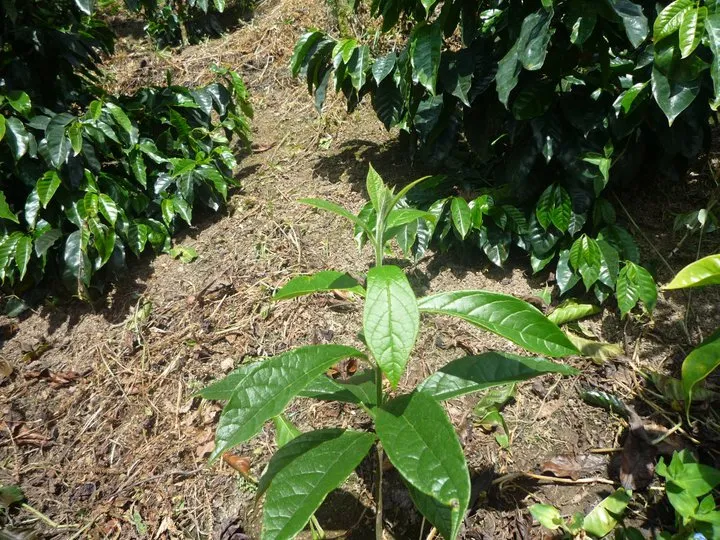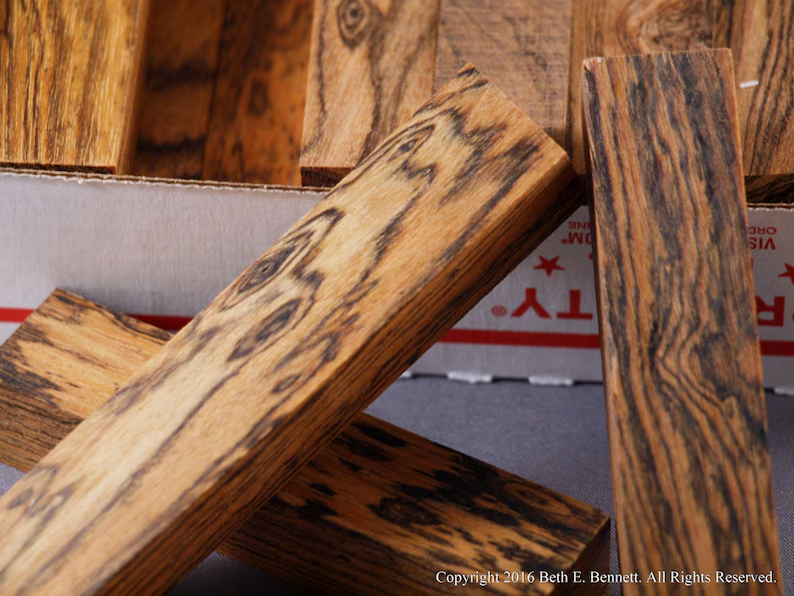WoodItGood is supported by its readers. We may earn an affiliate commission at no extra cost to you if you buy through a link on this page.
If you’ve been wonderin’ about Bocote wood, you’re in for a treat today!
Bocote is a stunning, exotic hardwood that’s makin’ waves among woodworkers, from seasoned pros to fresh-faced beginners.
Its unique beauty and workability make it a favorite for a variety of projects, and I’m here to give y’all the lowdown on this fantastic wood.
Origin and History

Bocote mainly comes from the lush forests of Central and South America, with Mexico being one of its primary sources.
This wood is like a hidden gem from the heart of the tropics. Imagine those dense, vibrant jungles where everything’s alive with color and sound… that’s where Bocote gets its start.
Now, Bocote isn’t just a recent discovery.
For centuries, indigenous peoples have cherished this wood. They used it to craft tools, weapons, and beautiful carvings.
Picture a time long before modern sawmills, where skilled hands turned raw logs into essential items for daily life.
The unique patterns and durability of Bocote made it a favorite for making bows, spears, and even intricate masks and figurines.
As time marched on and woodworking evolved, Bocote caught the eye of craftsmen far and wide. Its striking appearance and versatile nature made it a prized material.
Today, it’s highly sought after for everything from fine furniture and musical instruments to decorative inlays and small turning projects.
It’s a wood that’s woven through history, blending traditional uses with modern creativity.
So, whether you’re crafting a piece inspired by ancient traditions or adding a touch of tropical flair to a contemporary project, Bocote brings a rich heritage and a story worth telling.
Physical Characteristics

Alrighty, let’s get into the nitty-gritty of what makes Bocote wood so special when it comes to how it looks and feels.
First off, Bocote is a real looker.
This wood is like a show-off at a lumber yard beauty pageant. Its color ranges from a warm, golden brown to a deep, chocolatey hue, often with those dramatic dark streaks that can make it look a bit like a zebra.
If you’re into unique, eye-catching patterns, Bocote’s got you covered.
The grain of Bocote is typically straight, but it can sometimes get a little wild and interlocked.
This can give your projects a bit of character, like nature’s very own artwork.
The texture is smooth and fine, with a natural luster that makes it almost glow, especially after a good sanding and finishing.
Now, let’s talk about its heft. Bocote is a hardwood, which means it’s got some weight to it.
It’s not the heaviest wood out there, but you’ll definitely feel the difference compared to softer woods like pine.
This density also means it’s pretty sturdy and can take a bit of a beating without getting all dinged up.
One of the unique things about Bocote is its natural oils.
These oils give it that lovely sheen, but they can also play tricks on you when you’re gluing pieces together. You might need to do a bit of extra prep work to make sure everything sticks just right.
If bocote doesn’t sound like the wood for you, I can help you continue the hunt for the best hardwood for your project, check these out!
Working Properties

Well now, let’s chat about how Bocote behaves when you get down to workin’ with it.
This wood’s got a personality all its own, and you’ll wanna know its quirks before you dive into a project.
Bocote is a hardwood, and it’s a sturdy one at that. So, if you’re plannin’ on cuttin’ it with hand tools, you’re in for a bit of a workout.
Don’t get me wrong, you can absolutely do it, but you’ll want to keep those tools sharp as a tack. If you’ve got power tools handy, though, Bocote cuts like a dream… but be ready to sharpen your blades a bit more often than you would with softer woods.
This stuff has a way of wearin’ down blades quicker than you’d expect.
When it comes to sanding, Bocote is smooth as butter.
The fine grain and natural oils help it polish up to a silky finish without too much elbow grease. Just watch out for those natural oils when you’re tryin’ to glue pieces together.
Bocote’s oils can make glue a little finicky, so you might need to give your surfaces a good wipe with some acetone or sand them down a touch before gluin’.
That extra step will save you some frustration later on.
Now, here’s the good news: Bocote isn’t prone to tearout, so when you’re cutting or carving, you’ll get nice, clean edges, even on the grain’s wild side.
It’s also super easy to turn, which makes it a go-to for projects like pens, bowls, or small decorative pieces. Just think about how pretty that swirling grain is gonna look on a lathe!
Common Uses
Furniture Accents
Bocote’s bold patterns make it perfect for things like table tops, chair backs, and even small cabinets.
It’s not usually used for big, heavy furniture pieces, but rather those special accent parts where its beauty can really shine.
Think of it as the star of the show, adding that pop of elegance to an otherwise simple piece!
Musical Instruments
You’ll often find Bocote used in the world of music, too!
It’s popular for making things like guitar fretboards and parts of woodwind instruments, like flutes and clarinets.
The density of the wood helps produce a nice, resonant sound while the grain adds a touch of beauty, perfect for those who love both function and flair!
Turned Projects
If you’ve got a lathe, Bocote is a treat to work with.
Folks love turnin’ this wood into pens, bowls, handles, and even knife grips.
The smooth finish and striking patterns make these pieces look like you paid top dollar for ’em, even (and maybe especially) if they’re homemade!
Small Decorative Items
For smaller projects, Bocote’s just the ticket.
It’s perfect for jewelry boxes, picture frames, and cutting boards, any project where you want a bit of character and elegance.
The natural luster of Bocote means these pieces practically glow with beauty, and they’re durable enough to stand up to everyday use, too.
Durability and Maintenance
Well, let me tell ya, Bocote isn’t just a pretty face, it’s tough as nails, too!
This wood’s got natural durability that makes it a great choice for projects where you need something that’ll last.
Bocote has a good bit of resistance to rot, thanks to those natural oils it’s got runnin’ through it. It can be susceptible to pests like insects though.
That means you can feel confident using it for projects that might see a bit of moisture or wear, like cutting boards or outdoor furniture.
Just keep in mind, if you’re plannin’ on leavin’ it outdoors, you’ll want to seal it up good with a high-quality finish to protect it from the elements.
While it’s tough, it’s not invincible against rain and sun!
When it comes to maintenance, Bocote is pretty low-key.
For indoor projects, a little dustin’ now and then and a good buffing with some furniture polish will keep it lookin’ fresh.
Recommended Reading: Types Of Wood For Woodworking Projects 2024
If you’ve got a finish on it, you might wanna touch that up every so often, depending on the wear and tear, but overall, Bocote holds up real nice with minimal fuss.
And because of those lovely natural oils, Bocote tends to keep its luster without much extra effort. It’ll just keep on shinin’ with that rich, warm glow, even after years of use.
Availability and Cost
Well, darlin’, Bocote isn’t the type of wood you’ll find at your local hardware store next to the pine and oak.
It’s what we’d call an exotic hardwood, mostly comin’ from Central and South America, so it’s a bit harder to get your hands on.
You’ll likely need to order it from a specialty wood supplier or online. But trust me, it’s worth the hunt!
Now, let’s talk about cost.
Bocote’s beauty and durability do come with a price tag. It’s not the cheapest wood out there, that’s for sure.
For a beginner, I’d recommend startin’ with a smaller project to get a feel for it without breakin’ the bank.
Depending on the size and quality of the piece, you’re lookin’ at anywhere from $20 to $50 per board foot, sometimes even more for top-quality pieces.
That being said, because Bocote is so striking and long-lasting, a little bit can go a long way. A small board could turn into a jaw-droppin’ jewelry box or a set of elegant pen blanks.
So, while it’s on the pricier side, you’re gettin’ a wood that’s as beautiful as it is durable,and that makes it worth the splurge in my book!
If you’re not ready to dive in head-first with a big project, pick up a smaller piece and try your hand at something simple. That way, you get to experience the magic of Bocote without emptyin’ your wallet too much!
Common Sizes Bacote Wood Comes In
Here’s a handy list of the common sizes Bocote wood typically comes in, so you’ll know what to look for when you’re ready to order some:
- Lumber boards: Commonly available in thicknesses of 4/4 (1 inch), 6/4 (1.5 inches), and 8/4 (2 inches).
- Turning blanks: Perfect for projects like pens, bowls, or handles. Sizes often come in 1x1x12 inches for pens and 4x4x12 inches for larger turnings.
- Veneer sheets: For smaller, decorative applications, Bocote is available in thin veneer sheets, usually around 1/32 to 1/16 inch thick.
- Dimensional lumber: Smaller cuts, like 2×2 inches or 3×3 inches, can be found for projects like knife handles or tool grips.
These are some common sizes you’ll find, but always check with your supplier, as they might have custom cuts or sizes available too!
Pros and Cons of Bocote Wood
| Pros | Cons |
|---|---|
| Beautiful appearance with rich colors and striking grain patterns | High cost, especially for beginners |
| Durable and naturally resistant to rot and pests | Dulls blades quickly due to its hardness |
| Sands to a smooth finish with a natural luster | Natural oils make glueing tricky without extra prep |
| Versatile, suitable for a variety of projects | Limited availability, usually found at specialty suppliers |
| Works great for turning on a lathe | Environmental concerns, needs to be sourced responsibly |
| Low risk of tearout during cutting or carving |
Environmental Impact

Well now, when it comes to Bocote wood, we’ve gotta talk about the environmental side of things, because using such a beautiful, exotic wood comes with some responsibility.
Bocote is mostly harvested from tropical forests in Central and South America, and while it’s not on the endangered species list, it’s still considered a bit of a precious resource.
Overharvesting can be a real concern, especially when demand goes up. So, it’s important to make sure the wood you’re buyin’ is sourced responsibly.
What you’ll wanna look for is suppliers that follow sustainable practices.
Keep an eye out for certifications like FSC (Forest Stewardship Council), which means the wood was harvested in a way that supports forest health and ensures the livelihoods of the folks workin’ the land.
By buyin’ Bocote from reputable suppliers, you’re helpin’ protect the forests and the communities that rely on ‘em.
Another thing to keep in mind is that because Bocote’s an exotic hardwood, it has to be transported long distances, which adds to its carbon footprint.
That’s why it’s a good idea to use this wood thoughtfully, maybe save it for special projects that’ll last a long time.
A little Bocote can go a long way, and that way, you’re not wastin’ a precious resource.
So, while Bocote is a stunning wood to work with, we all gotta do our part to make sure we’re gettin’ it in a way that’s sustainable for both the environment and the people who depend on those forests.
Look for ethical sources and use it wisely, and you’ll be craftin’ with a clear conscience.
If you wanna know even more about sustainability and woodworking, I have a whole article for you.
Well, folks, that’s the scoop on Bocote wood!
From its roots in the rich forests of Central America to its stunning beauty and durability, Bocote has plenty to offer any woodworker lookin’ for something special.
Whether you’re crafting small decorative pieces or larger projects, Bocote brings elegance and strength in spades.
Just remember, it’s a bit of an investment and takes a little care, but with the right tools and a mindful approach, you’ll have a piece that’ll stand the test of time.
So, next time you’re eyein’ something fancy for your next woodworking project, give Bocote a try. You’ll be wowed by its striking patterns and how beautifully it works up.
Plus, when you choose it from a responsible supplier, you’re doin’ your part to keep those forests healthy.
If you’ve ever worked with Bocote, or if you’re plannin’ a project with it, drop a comment below and let me know how it goes! I’d love to hear what you’re makin’ and how Bocote is treatin’ ya. Happy craftin’, y’all!

